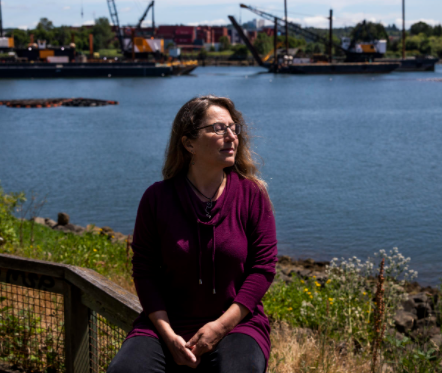
According to BJ Cummings, Duwamish River Cleanup Coalition founder and community engagement manager for the UW Superfund Research Program, expansion of the Port of Seattle and the need for industrial land reduced the 12-mile Duwamish Watershed, from a river teaming with sea life into a five-mile-long shipping canal. She described how a decades-long ‘call to action’ for future decisions about the Duwamish River is finally well underway.
“After 25 years of working on the Duwamish River, I’ve become a river junkie with the river deep into my heart, as our waterways tell us something about who we are,” she began, “and how the river is a reflection of Seattle’s history.”
A map showed the extent of the Duwamish Watershed from Mt. Rainier ice caves at 5,000 feet to the Puget Sound. Promoters of the rapid expansion of the Port had little concern for the impact of their work on native peoples or the environment. It wasn’t until the mid-1970s that native bones from burial grounds and artifacts from native villages were found as bulldozers made way for ‘factories’ along the banks of the Duwamish.
Tribal leaders and environmentalists reached out to the Federal government while ancient native villages were ravaged by expansion. “Finally, in the late 70s the federal government required the Port to study the history of the Duwamish where 80-90% of the artifacts had already been destroyed,” she said.
Changes to the Duwamish River began soon after white settlers homesteaded along the river’s banks. Beginning in 1895 city officials sought to build out an industrial corridor along the Duwamish with ‘factory islands’ on the mudflats. “On this land will be the foundation for a major portion of the industrial fabric of the city,” according to local officials at the time. “The grain terminals, Harbor Island, and the SODO area are a testament to this work”, she said. Harbor Island was the largest man-made industrial site in the U.S. at that time with all the downriver land constructed for shipping, industry, and agriculture.
During more than 100 years, the river was manipulated in dramatic ways for industrial and agricultural expansion, eliminating meandering smaller rivers and redirecting others to prevent flooding of farmlands. The Duwamish Tribal Council with many sixth and seventh-generation members is spearheading efforts to restore the watershed as much as possible after “white colonial settlements turned the flow of the river upside-down”. While the region’s indigenous people coped with emerging white settlers, land deals were negotiated as homesteaders carved plots of land on Beacon Hill while tidelands were turned into Seattle’s industrial hub.
In the late 1990s, the tribal council and their supporters established the Duwamish Clean Up Coalition to transform the once industrial dumping ground of the river. Restoration of salmon runs in the Duwamish is one way to restore the river to a place where cultural revitalization is taking place. “We are building a movement of native peoples now joined by new waves of immigrants in South Park and Georgetown who are now taking up the cause of the river,” she concluded. “The Duwamish River Community Coalition aims to show how the wealth of the city was built on the backbone of the Duwamish River while restoring the river as much as possible.”
President Jimmy rang the bell promptly at 12:30 followed by Ryan Bunbury’s rendition of ‘Jingle Bells’ and the day’s inspiration delivered by Bill Center, accompanied by Todd Summerfelt, quoting ‘philosopher-poet’ Dolly Parton: “I still believe” -- believe that we will walk again in the sunshine by the seashore – and believe there’s a day coming soon when we’ll unmask – Gotta believe in a higher power in the midst of our darkest hour”….
President Jimmy announced the return of in-person meetings beginning January 5th at the Westin and followed by every first and third Wednesday. He recognized recently elected club leaders – five new members of the Rotary Board of Directors, Seattle Rotary Service Foundation’s five new members, and club officers that will serve from July 2022 to July 2023.
Joel Ferrell of the Community Service Committee reported on their 21st annual holiday shopping program for homeless youth. He said the program began in 2001 taking homeless children out to do shopping in the downtown Seattle core. Since its inception, more than 600 children, 6 to 16 years of age, have participated in this holiday experience. And special thanks to SRSF and the Rotary Boys & Girls Club that have supported this effort with funding and coordination.
Past Seattle #4 president and District 5030 Governor,
Cathy Gibson encouraged all Rotarians to take the Global Climate Pledge, which simply asks that we make small changes in our everyday lives to help the environment.
Program Chair, David Fain, said the meeting on January 5 at the Westin and on ZOOM will feature Andrea Driessen who will talk about Gracenotes: The Active Tool to Boost Meaning, Mattering, and Legacy – for organizations helping to find a deeper purpose in their work and community engagement.

Thanks Newsletter Reporter Pete DeLaunay!
